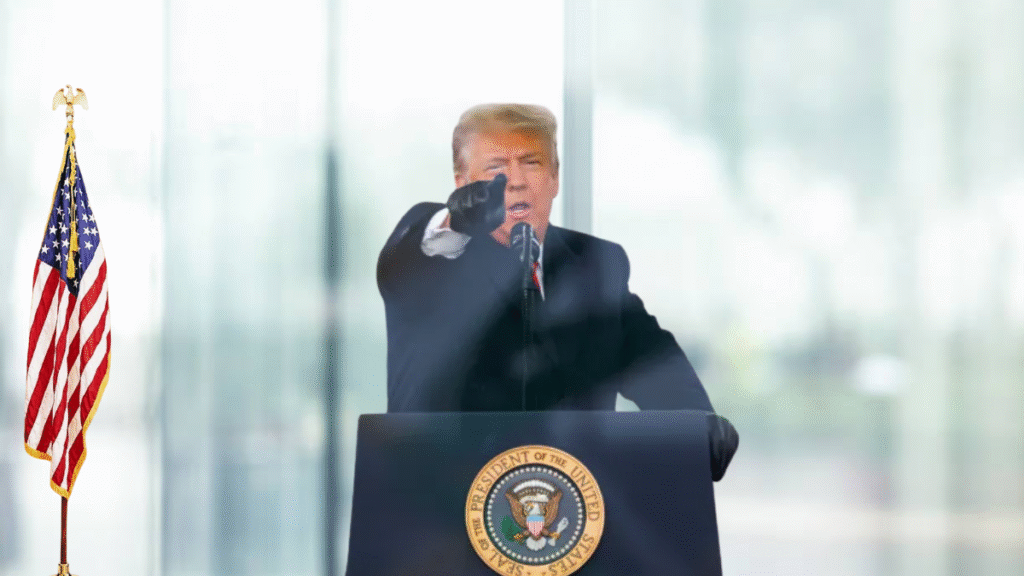Table of Contents
Introduction: A Shockwave in Washington
On June 21, 2025, reports of a unilateral U.S. strike on Iran’s nuclear facilities—Fordow, Natanz, and Isfahan—shook the global stage. But the aftershock was even more severe at home. Within 72 hours, the House floor buzzed with articles of Trump impeachment 2025, marking a third attempt to remove him from office. This blog breaks down the who, what, and why behind the Trump impeachment 2025 wave, dissecting the legal arguments, political fallout, and what comes next.
What Triggered the Trump Impeachment 2025 Push?
The alleged trigger for the latest Trump impeachment 2025 effort was his authorization of airstrikes in Iran without prior congressional approval. Lawmakers—especially progressive Democrats—deemed this a violation of the War Powers Clause under Article I, Section 8 of the U.S. Constitution. Trump’s defenders argue that national security threats required swift action. But opponents claim it’s a repeat of his 2020 Iran strategy—only more reckless.
House Resolutions in Focus: H.Res. 353 to H.Res. 537
In response, a flurry of House resolutions—most notably H.Res. 353, H.Res. 489, and H.Res. 537—were introduced in rapid succession. These resolutions form the core of the Trump impeachment 2025 argument, alleging abuse of power, reckless endangerment of international law, and circumvention of congressional authority. Each resolution has become a rallying point for various political factions.
Public Sentiment and Grassroots Movements
The Trump impeachment 2025 movement isn’t just fueled by Washington insiders. Grassroots organizations like Democracy Now, Veterans for Peace, and Students Against War have organized rallies in over 30 states. Twitter trends such as #ImpeachTrump2025 and #IranWarDebacle have added digital fuel to the political fire.
Legal Arguments: What Constitutional Experts Say
Legal scholars are split. While some argue that Trump impeachment 2025 is warranted under the War Powers Resolution, others note that previous presidents have taken similar actions without impeachment. What sets this case apart is the lack of prior consultation with Congress, combined with existing partisan fatigue from Trump’s earlier impeachments.
Trump’s Defense: Playing the Patriotism Card
Trump has launched a media counteroffensive, branding the Trump impeachment 2025 movement as “radical leftist sabotage”. He claims the Iran strikes were necessary to prevent a nuclear threat and insists that national interest trumps procedural formalities. This framing has resonated with many in his base, especially in swing states.
Political Fallout and the Road to 2026
Whether or not Trump impeachment 2025 succeeds, the political ramifications are already in motion. Republicans accuse Democrats of weaponizing impeachment for election gains. Independents are increasingly frustrated with Congressional gridlock. The impeachment proceedings may overshadow legislative agendas heading into the 2026 midterms.
Constitutional Basis: Separation of Powers & Emoluments Clause

At the heart of these impeachment efforts lie foundational legal principles:
- Separation of Powers: Trump’s unilateral strike on Iran is argued to have bypassed Congress, violating Article I, Section 8 of the Constitution.
- War Powers Clause: The 1973 War Powers Resolution was allegedly ignored—Congress was not formally notified, and no authorization for force was granted.
- High Crimes & Misdemeanors: House Democrats frame Trump’s behavior as a pattern of disregard for constitutional norms, similar to the abuse charges filed in the first and second impeachments.
- Emoluments Clause (mentioned in Thanedar’s resolution): Trump allegedly continues to profit from international business dealings via Truth Social-related investments and Mar-a-Lago visits by foreign diplomats.
Legal experts remain split on whether these charges meet the constitutional threshold for impeachment, but the political significance is undeniable.
Grassroots Pressure: The 50501 Movement & Free Speech For People
While impeachment stalled in Congress, activists on the ground reignited public pressure. The 50501 movement—named for “50 protests in 50 states on 5/01”—mobilized millions. In one of the largest nationwide demonstrations since 2020, organizers claimed over 5 million participants turned out to demand action against “tyranny.”
Free Speech For People, an advocacy organization, launched ImpeachTrumpAgain.org, collecting nearly 3 million signatures by June. Their central argument: Trump’s Iran strike violates the spirit of democracy and threatens U.S. global standing.
“Our nation is not meant to be ruled by kings,” read a widely-shared protest placard in D.C.
This activism significantly increased media pressure and helped amplify calls from progressive lawmakers like AOC, Ilhan Omar, and Jasmine Crockett, the latter of whom has vowed to reopen the impeachment inquiry if promoted to ranking member in the next Congress.
Public Sentiment & Market Reaction: Polymarket Odds & Axios-AM Data
Beyond the halls of Congress and street protests, financial markets also responded.
On Polymarket, a popular crypto-based prediction platform, impeachment odds surged to 6% in early July 2025. Over $1.3 million was wagered on the likelihood of Trump’s removal by year’s end, a sign that political risk is once again influencing investor behavior.
According to Axios AM, trust in Trump’s foreign policy dipped 12% after the Iran strikes, with younger voters and independents showing the sharpest decline. Political analysts suggest this may affect 2026 midterm elections, potentially swinging the House in favor of pro-impeachment Democrats.
Judicial Fallout: Roberts, Shadow Dockets & Executive Power
One of the underreported but critical angles of this story involves the Supreme Court.
Chief Justice John Roberts privately expressed concern about the constitutionality of Trump’s military action, according to leaks covered by The Daily Beast. Though no official ruling has been made, legal scholars believe the “shadow docket” (emergency rulings without full hearings) may soon be used to rule on war powers-related petitions.
Meanwhile, some progressive groups are calling for the judicial branch to reaffirm limits on executive power, a fight that could shape future U.S. foreign policy norms.
FAQs: Breaking Down Trump Impeachment 2025
Q1: Is this the third time Trump has been impeached? Yes. Trump impeachment 2025 marks the third impeachment effort following those in 2019 and 2021.
Q2: What are the main legal grounds for the 2025 impeachment? Primarily the War Powers Clause, abuse of executive authority, and violation of the Logan Act.
Q3: Will this impeachment go through the Senate? Unclear. The Senate remains closely divided, and moderate Republicans may be key swing votes.
Q4: What impact could Trump impeachment 2025 have on the election? It may energize both Trump’s base and his opposition, polarizing the electorate even further.
Conclusion: A Nation on Edge
Trump impeachment 2025 isn’t just another headline—it’s a political turning point with global implications. As lawmakers debate, citizens protest, and media outlets dissect every move, one thing is certain: America’s political fabric is being stress-tested yet again.
Read another guide: Trump administration democracy cuts.




